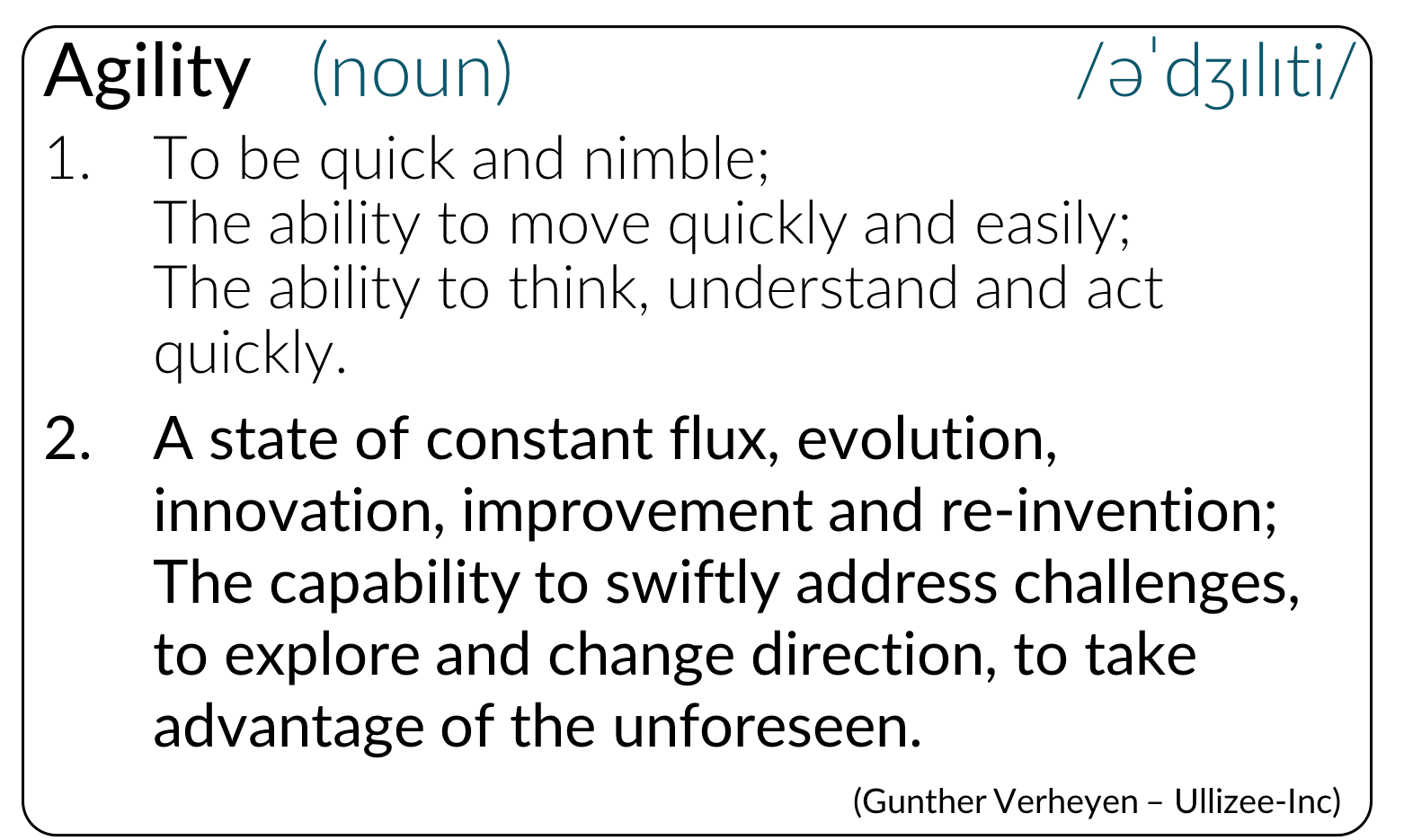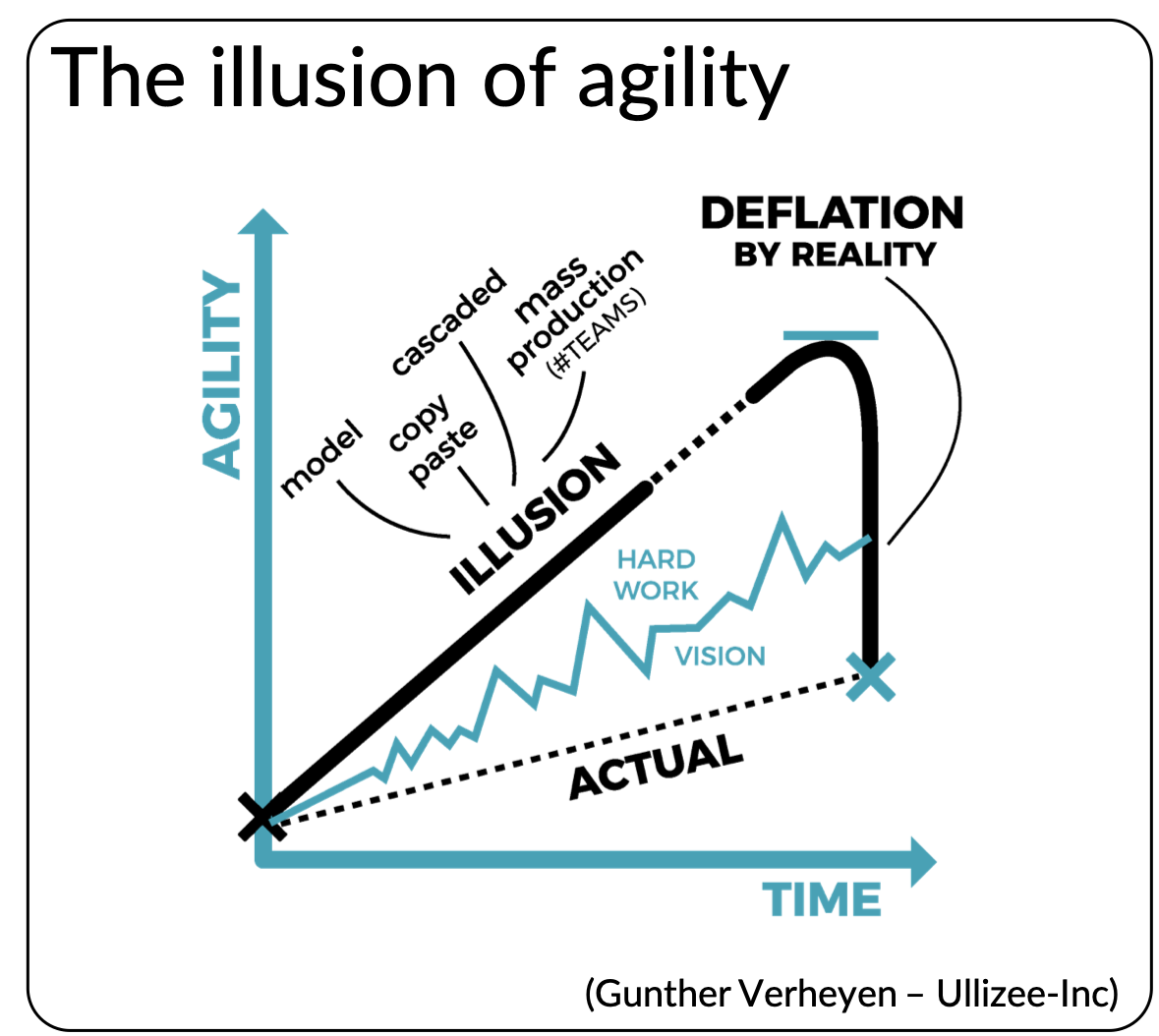(fyi: this text has been slightly adapted from the original text that can be found at https://guntherverheyen.com/2019/01/07/the-illusion-of-agility-what-most-agile-transformations-end-up-delivering/)
Agility is a continuously evolving state that is unique to a specific organization, given that organization’s people, its constructs and its history. A traditional (industrial) approach to becoming more Agile (adaptive) commonly creates no more than an illusion of agility.
Agility is a specific state because it reflects the unique lessons and learnings that an organization and its inhabitants went and go through, the way in which specific annoyances and hindrances were and are overcome, the many inspections and adaptations that occurred along the journey, the unknown future challenges that will require distinct responses. Agility is a unique signature with imprints of the people involved and their relationships and interactions, of used and abandoned tools, processes, practices, and of constructs within and across the many eco-systems that make out an organization, not even limited to the organization’s borders.
No model can predict, anticipate or outline the unique signature that an organization's state of agility is.

Many of our organizations have their roots in the past industrial age. Their beliefs, intuitions and practices are thus rooted in the traditional approaches from that age. Today, most of these organizations, in order to survive and certainly to prosper, feel the urgent need to increase their agility and shift (or rather: leap) to the Agile paradigm. They naturally and instinctively revert to their familiar (i.e. industrial) recipes, the recipes in which they were bred and raised and that may have brought them success in more stable times. They cautiously plan out their attempts to shift to the Agile paradigm, which often consumes large amounts of time before even the first foot is moved. They wrap their attempts commonly in separate structures like change projects. They imitate what other organizations do. They look at peer and other organizations and copy-paste what these organizations claim brought them success. They enforce processes and practices in a cascaded and mass-production way, meanwhile pushing for volume rather than value. They rely on text-book models that prescribe generic pre-empted organizational structures. The learnings and the hard work needed to acquire sustainable agility are conveniently ignored. Ironically, these old approaches are the exact approaches that impede these organization's envisioned and much needed agility. They are the exact practices that work no more, the practices they need to abandon in order to enter and survive the new worlds that require higher agility.

No more than an illusion of agility is created through the use of these old ways. The deflation (by reality) hits hard when -often after a few years- it turns out that the envisioned (and much needed) results are not achieved. The engagement of the people creating the company’s products and services does not increase (rather they keep leaving while the organization's attractiveness for new talents remains low). The people funding the work are not pleased (not achieving the gains and returns hoped for). The people buying and consuming the organization’s products and services are not more satisfied (and usage and satisfaction keep declining). Overall, the old predominant phenomenon of disconnectedness, within and across the existing organizational structures, is not resolved. The old-school top-down line organization (with its typical silo structure and separation of skills and expertise) is not replaced with team work, shared purpose and commitment. Blaming keeps taking precedence over collaboractiveness. The deflation by reality results in unfortunate, if not extremely painful, findings given the many human and financial spendings that likely went into the transformation effort. Most likely, blaming keeps taking precedence...
Increasing agility is a path. Progressing on that path requires vision, belief, persistence and… hard work. Agility, as a state of high adaptiveness, is achieved by regularly adapting, changing direction and course, upon inspections of actual work and observable results. It requires feedback loops. Organizations often deny themselves the room for learning, because it was not what the industrial paradigm acknowledged or because the economic pressure is too high. Regardless, the new reality says that what works today might not work tomorrow. What works for one combination of teams, technology and business might not work for another combination. It's why we need to increase our ability to... adapt.
Signposts that tell you that you are in or are creating an illusion of agility are:
- It is not a transformation if it doesn’t change how you work.
- It is not an Agile transformation if it doesn’t simplify how you work.
- It is not an adoption of Scrum if it doesn’t engage and energize people (customers, teams, stakeholders).
All endeavors towards embracing a state of agility are pointless when not at least accepting, and even better embracing, uncertainty and unpredictability. The logical approach is to increasingly act in the moment, and to expect all involved to embrace these givens. Engage people by living the art of the possible against unpredicted outcomes. People love opportunities to shape their future. Getting the most out of the possible thrives upon acceptance of the unwritten state of the future and what that future might bring. Acceleration (of agility) comes from vision, determination and dedication; from the courage to move away from following a plan or copying a model.
More Agile teams does not make a more Agile organization.
Regardless an organization’s past attempts and choices, reverting to the path of hard work is always a workable way out.
Note. The team from Higher View provided the professional expertise for the video creation.
